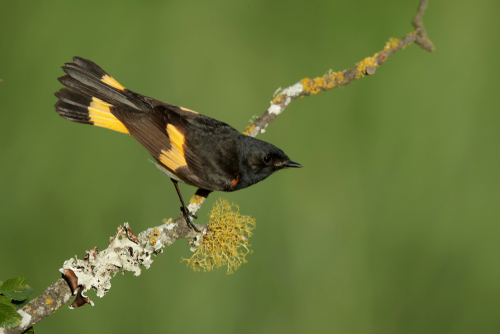
American Redstart, Setophaga ruticilla
Bill Rowe
What is a warbler? A birder from the U.S. or Canada will tell you that it is one of about 50 small insect-eating species that breed north of Mexico, a captivating group with the most varied color patterns and songs. A birder from the Old World will describe their warblers differently (a lot of them are truly obscure and confusing) and will use the term “wood-warblers” for our exclusively New World rainbow of little birds in the family Parulidae. Out of the 35 species that can be seen annually in the St. Louis area, one of the undoubted favorites is the American Redstart, with its unique and memorable colors. Unlike some warblers that tend to stay high up in the trees, the redstart will show off for you as it flycatches at mid-levels, and it occurs in large numbers during migration, often in local parks or your own yard. Like nearly all the warblers, it migrates south to spend the winter in Mexico, Central America, the Caribbean, and northern South America. Once back in North America for nesting, it fans out all across southern Canada, much of the eastern U.S., and parts of the west.
IDENTIFICATION: The male redstart is unmistakable, a black-and-vermilion sprite jumping around in the foliage, spreading its tail to show off the color better. The female is similar in pattern but with the black replaced by gray on the head and greenish on the back, and with the orangey-red patches replaced by yellow. Young males resemble females while in their first fall and the following spring.
ST. LOUIS STATUS: Redstarts are among our commonest warblers on migration, in April-May and again in August-September. In between, during the summer months, they are regular nesting birds here but localized, no longer a yard and park bird, as they prefer mature bottomland woods, often near creeks and rivers (“riparian” forest). For their occurrence in winter, we use the term “accidental,” meaning “practically never”—in fact, there are only two known instances of a redstart being seen in winter in Missouri, and we don’t know whether they survived.
Learn more and listen to the thin, high-pitched songs of the American Redstart here.




